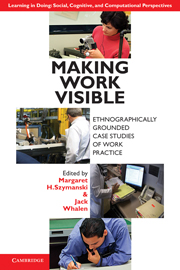Book contents
- Frontmatter
- Contents
- List of Figures and Excerpts
- List of Tables
- List of Contributors
- Series Foreword
- Foreword by John Seely Brown
- Acknowledgments
- Introduction
- Part I Work Practice Study in Historical Context
- Part II Applying Work Practice Methods
- Part III Practices around Documents
- Part IV The Customer Front
- Part V Learning and Knowledge Sharing
- 14 Communal Knowledge Sharing
- 15 Designing Document Solutions for Airline Maintenance Advisories
- 16 Transforming Information System Design
- 17 Rethinking How Projects Are Managed
- Part VI Competency Transfer
- References
- Index
- LEARNING IN DOING: SOCIAL, COGNITIVE AND COMPUTATIONAL PERSPECTIVES
17 - Rethinking How Projects Are Managed
Meeting Communication across the Organizational Hierarchy
Published online by Cambridge University Press: 05 August 2012
- Frontmatter
- Contents
- List of Figures and Excerpts
- List of Tables
- List of Contributors
- Series Foreword
- Foreword by John Seely Brown
- Acknowledgments
- Introduction
- Part I Work Practice Study in Historical Context
- Part II Applying Work Practice Methods
- Part III Practices around Documents
- Part IV The Customer Front
- Part V Learning and Knowledge Sharing
- 14 Communal Knowledge Sharing
- 15 Designing Document Solutions for Airline Maintenance Advisories
- 16 Transforming Information System Design
- 17 Rethinking How Projects Are Managed
- Part VI Competency Transfer
- References
- Index
- LEARNING IN DOING: SOCIAL, COGNITIVE AND COMPUTATIONAL PERSPECTIVES
Summary
In the summer of 2003 a team of fieldworkers set out to observe the development of a large IT system for a manufacturing company. The company had recently been spun off from a much larger organization, and whereas it was still using the IT systems of the organization it had been part of, the license for those systems would soon expire. The IT vendor had been selected to build an entirely new enterprise information system. It was a big project so in order to circumscribe the observational work the fieldworkers focused on the team responsible for the sales subsystem.
From the start there was trouble. The sales department of the manufacturing organization had dispatched a small group to work with the IT vendor to establish the requirements for the system and they insisted that the new system must support their current work flow, even though the software package their management had chosen in the early negotiations of the project was expressly designed for a different workflow. So the sales department's representatives made numerous requests to have the software package altered in fundamental ways. Furthermore, the sales subsystem team from the IT vendor was relatively inexperienced. Their leader had been selected because of his success in a previous project, but he was familiar neither with typical sales work processes nor with the software package. The junior person knew about the software package, but not sufficiently to answer the customer's many detailed questions.
- Type
- Chapter
- Information
- Making Work VisibleEthnographically Grounded Case Studies of Work Practice, pp. 312 - 324Publisher: Cambridge University PressPrint publication year: 2011



